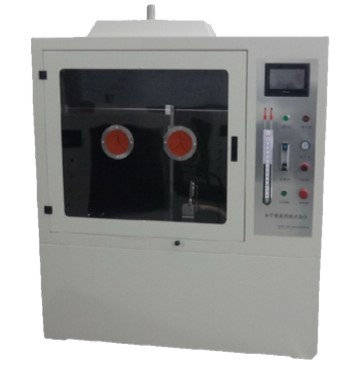
NewsInformation Center
Why does cotton melt during a burning test?
2023/02/15
Why does cotton melt during a burning test? Before we can get an answer, we must first understand the question of the melting point of cotton.
Cotton burns with three characteristics
1. Flammability. The main components of cotton fibres are cellulose and wax, fat, etc., all of which are combustible, its ignition point is 150 degrees, the self-ignition point is 407 degrees, oxygen index 20.1, each kilogram of cotton needs at least 4m^3 air for complete combustion, the flame temperature of combustion is 1500 degrees, the calorific value is 17200 to 17600 kJ/kg. As cotton fibres are fine and fluffy, they have a large contact area with air and can cause combustion when they meet a very small fire. The burning speed of cotton is about 16 to 25 times that of wood, and once it catches fire, it can be expanded into pieces instantly.

2, negative combustibility. Already packaged cotton, after encountering a fire, sometimes due to the lack of oxygen supply, often make burning in a local or small area slowly, this burning can not see the fire, but also can not see the smoke, in the negative combustion state. It can last for several days, or even dozens of days, and is not easily detectable. The cotton of the negative combustion, due to the lack of oxygen, can not be completely burned, will produce carbon monoxide, carbon monoxide spontaneous combustion point is 610 degrees, the explosion limit is 12.5% ~ 74%. When the Yin-fired cotton suddenly encountered air convection, not only can make the Yin-fired quickly into complete combustion, and can cause the mixture of carbon monoxide and air to explode. At the same time, the primary layer of cotton fibers is mainly waxy, not absorbent, water is difficult to penetrate when fighting, so the surface of the cotton fire extinguished with water, the internal still lurks the risk of negative combustion, after a certain period of time can also re-ignite.
3、Spontaneous combustion. As cotton in the picking, processing process, has stuck to a large number of microorganisms, cotton fibres also contain about 0.6% of fat, wax and 1.2% of pectin. When the water content of cotton is high, the microorganisms grow and multiply rapidly and generate heat. As cotton has poor thermal conductivity, the heat cannot be dissipated and it gradually accumulates, making the temperature rise continuously. When the temperature reaches 70 degrees, the microorganisms cannot survive and gradually die. At this point the unstable compounds in the cotton fibres appear to char and further adsorb water vapour, releasing heat and making the temperature continue to rise. When the temperature reaches 150 - 200 degrees, the cellulose begins to decompose and enters the oxidation process, the reaction is accelerated, the heat increases, and under conditions where the accumulated heat does not dissipate, it burns itself.
For the combustion characteristics of cotton, in the cotton storage should pay attention to the following points.
1, reasonable layout. The site for storing cotton should be separated from the processing workshop, the storage capacity is larger (more than half a year processing capacity), storage longer (more than half a year), should be managed in accordance with the requirements of the warehouse. The warehouse (yard) should be located in the production, office, living area, the wind direction of the dominant wind all year round, the two should be separated from each other by a wall, not adjacent to it, and not located in the production, living, office area.
2, the cotton processing process generated by the offcuts, especially sticky grease offcuts, damp offcuts of cotton, should be stored separately, shall not be put into the cotton warehouse, and should strengthen management to prevent spontaneous combustion.
3, staff, cotton sales staff, in addition to production must not enter the warehouse (yard) area at will. Temporary entry into the warehouse (yard) area of the personnel should strictly carry out registration procedures, and hand over the fire.
4. There shall be no overhead electric wires in the cotton yard. The wires used in mobile stacker cranes must not have connectors, clutches or electromagnetic switches should be used and the use of inverted smooth openings is prohibited.
5, timely sweeping of fallen cotton, electrical equipment around the cotton lint should be removed frequently to keep clean.
6, electrical appliances should be operated by professional electricians, generally can not be operated by temporary workers, not to let people who do not know electrical safety knowledge to touch the electrical equipment.
7, the seed cotton stack and lint stack should be partitioned and stacked, not mixed pile.
8, broken bales, loose bales shall not be stacked on the stack, should be stored centrally, by repacking before stacking.
9, indoor cotton warehouse should be maintained in accordance with the provisions of the "five distance", open-air storage yard storage volume is larger, should be set up in accordance with the provisions of the sub-field, grouping, stack size, spacing should be in line with the safety provisions. Cotton processing plant's cotton storage capacity exceeds its storage capacity, the amount of cotton should be transferred away in a timely manner, to prevent over-storage, in order to facilitate safety.
10、The processed lint cotton should be transported into the warehouse or special yard in time, and should not be stored in the workshop.

Recommended instruments for cotton burning tests: 45 degree flammability tester, Horizontal Vertical Combustion Tester, etc.

Recommended instruments for cotton burning tests: 45 degree flammability tester, Horizontal Vertical Combustion Tester, etc.
Previous: The 45 degree flammability tester has a wide range of applications in the textil
N e x t : Do you know what are the main regulations for the quality control of textiles in



